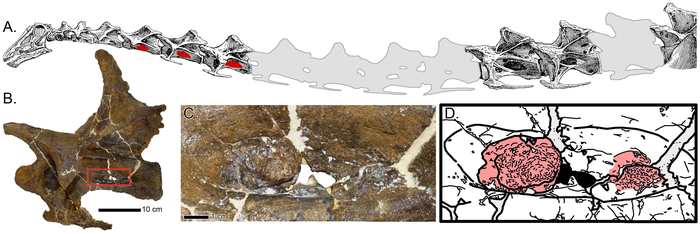MALTA, Montana (Feb. 10, 2022) – The fossilized remains of an immature diplodocid – a large, long-necked herbivorous sauropod dinosaur, like “Brontosaurus” – may provide the first evidence of a unique respiratory infection in a dinosaur, according to a study published in Scientific Reports. The findings increase our understanding of the illnesses that affected dinosaurs.

Credit: Woodruff, et al.
MALTA, Montana (Feb. 10, 2022) – The fossilized remains of an immature diplodocid – a large, long-necked herbivorous sauropod dinosaur, like “Brontosaurus” – may provide the first evidence of a unique respiratory infection in a dinosaur, according to a study published in Scientific Reports. The findings increase our understanding of the illnesses that affected dinosaurs.
The specimen, nicknamed “Dolly,” was discovered in southwest Montana, USA, and dates back to the Late Jurassic Period of the Mesozoic Era (approximately 150 million years ago). Cary Woodruff of the Great Plains Dinosaur Museum in Malta, along with his colleagues, examined three of the cervical vertebrae (the bones from the neck) from Dolly and identified never-before-seen abnormal bony protrusions that had an unusual shape and texture. These protrusions were located in an area of each bone where they would have been penetrated by air-filled sacs. These air sacs would have ultimately connected to Dolly’s lungs and formed part of the dinosaur’s complex respiratory system. CT imaging of the irregular protrusions revealed that they were made of abnormal bone that most likely formed in response to an infection.
“Given the likely symptoms this animal suffered from, holding these infected bones in your hands, you can’t help but feel sorry for Dolly,” Woodruff said. “We’ve all experienced these same symptoms – coughing, trouble breathing, a fever, etc. – and here’s a 150-million-year-old dinosaur that likely felt as miserable as we all do when we’re sick.”
Based on the location of these abnormal bony protrusions, the researchers suggest that they formed in response to a respiratory infection in Dolly, which ultimately spread into these neck vertebrae via the air sacs and caused the irregular bone growths. The authors speculate that this respiratory infection could have been caused by a fungal infection similar to aspergillosis, a common respiratory illness that affects birds and reptiles today and can lead to bone infections. In addition to documenting the first occurrence of such a respiratory infection in a dinosaur, this fossilized infection also has important anatomical implications for the respiratory system of sauropod dinosaurs.
“This fossil infection in Dolly not only helps us trace the evolutionary history of respiratory-related diseases back in time, but gives us a better understanding of what kinds of diseases dinosaurs were susceptible to,” Woodruff said.
The researchers suggest that if Dolly had been infected with an aspergillosis-like respiratory infection, it likely experienced flu or pneumonia-like symptoms such as weight loss, coughing, fever, and breathing difficulties. As aspergillosis can be fatal in birds if untreated, a potentially similar infection in Dolly could have ultimately caused the death of the animal, they add.
In addition to Woodruff, the research team included a paleopathologist/veterinarian, Ewan Wolff (University of New Mexico); a veterinarian, Sophie Dennison (TeleVet Imaging Solutions, Oakton, Va.); and two paleontologists who are also medical anatomists, Mathew Wedel (Western University of Health Sciences, Pomona, Calif.) and Lawrence Witmer (Ohio University Heritage College of Osteopathic Medicine, Athens, Ohio).
Journal
Scientific Reports
DOI
10.1038/s41598-022-05761-3
Subject of Research
Animals
Article Title
The first occurrence of an avian-style respiratory infection in a non-avian dinosaur
Article Publication Date
10-Feb-2022




